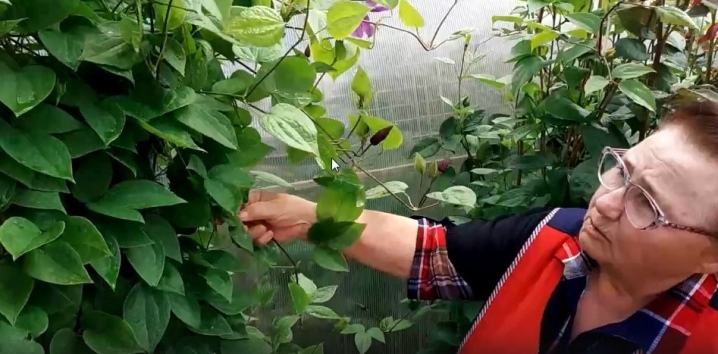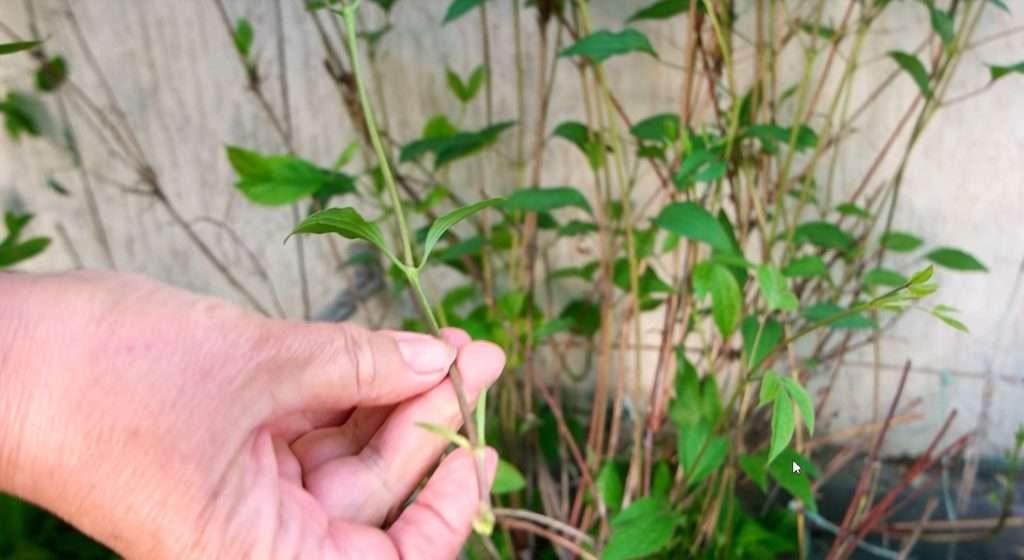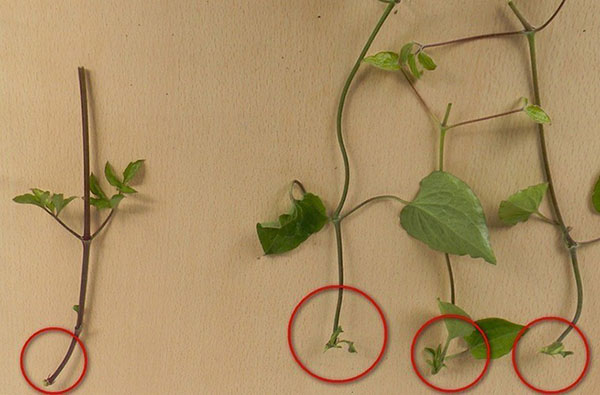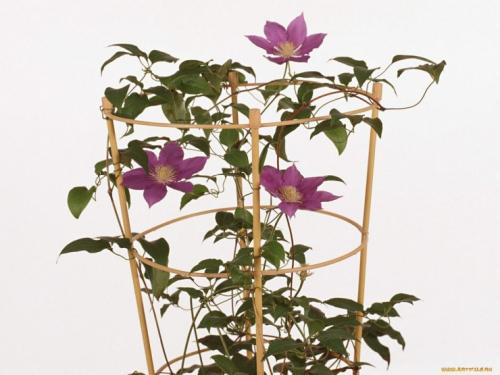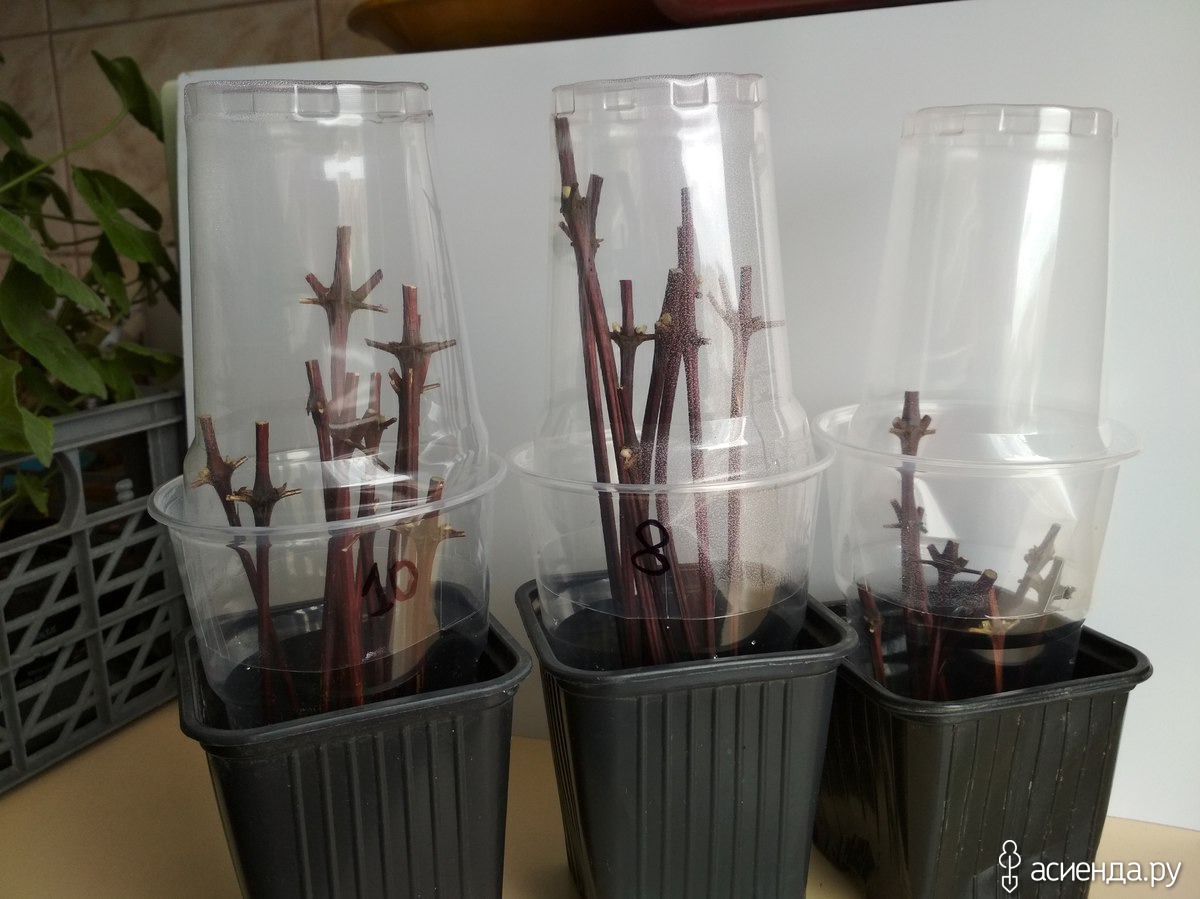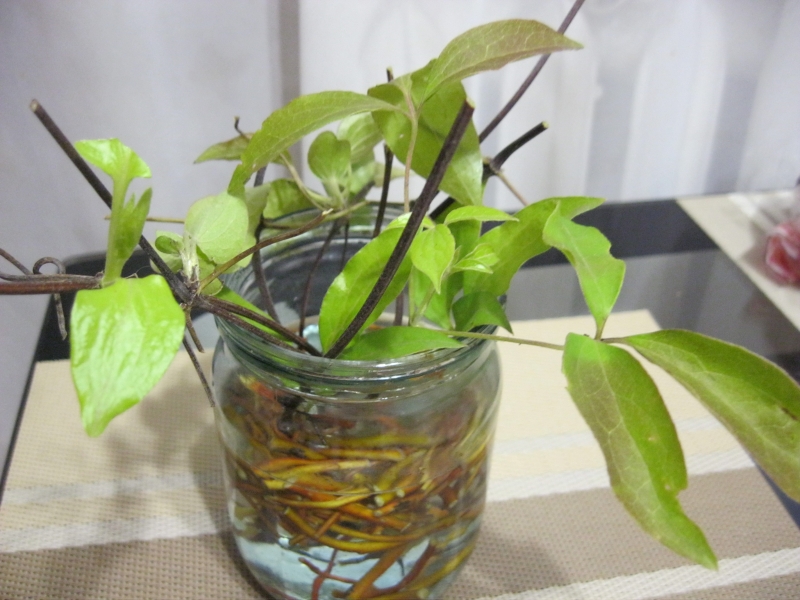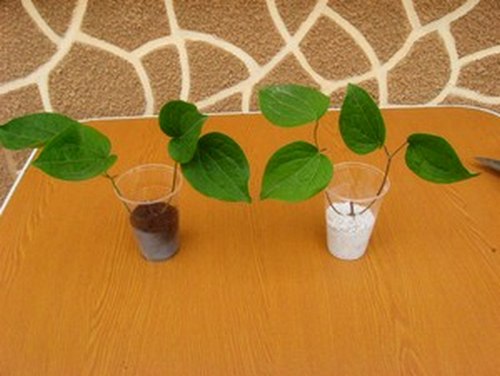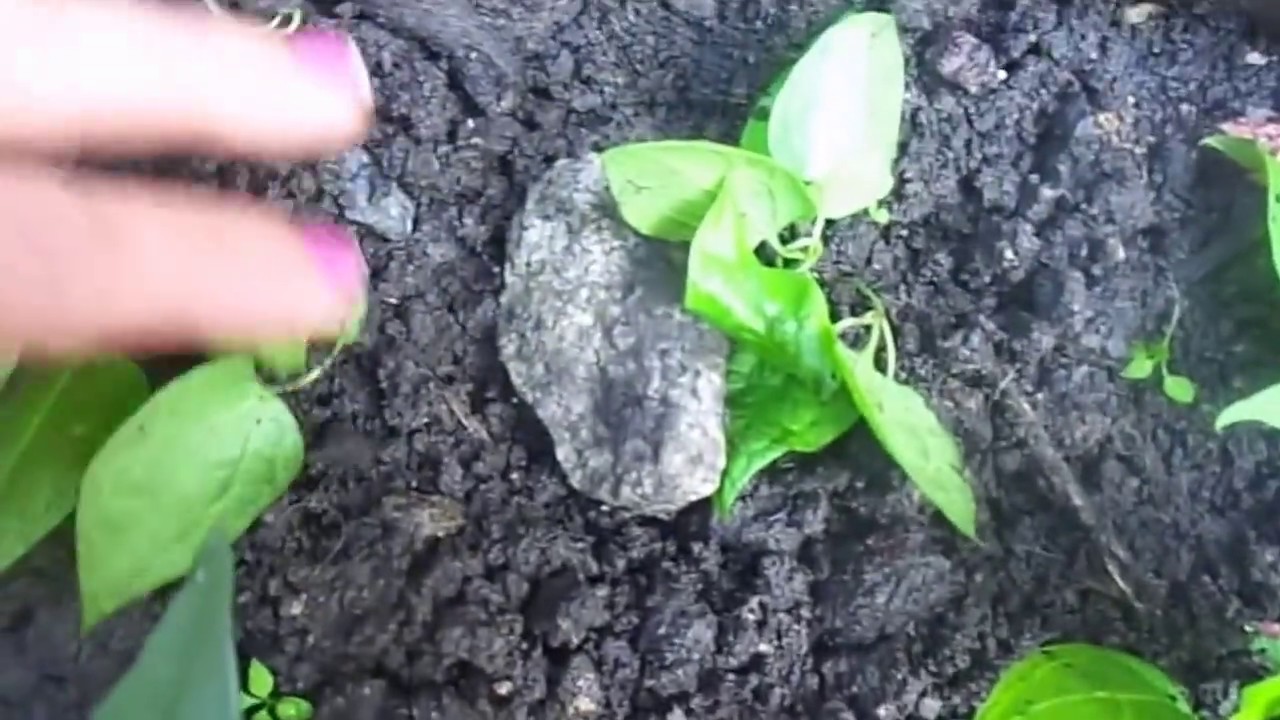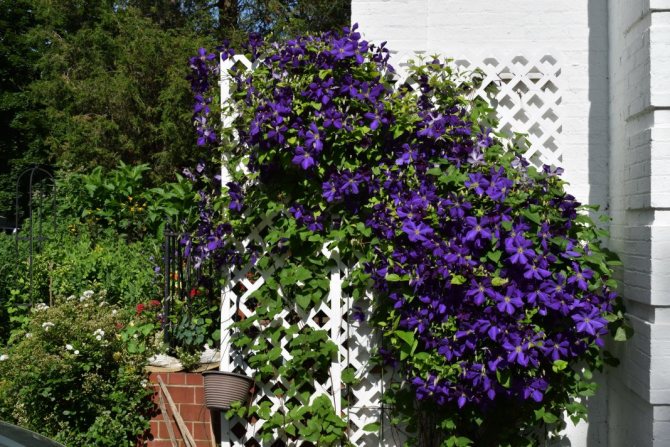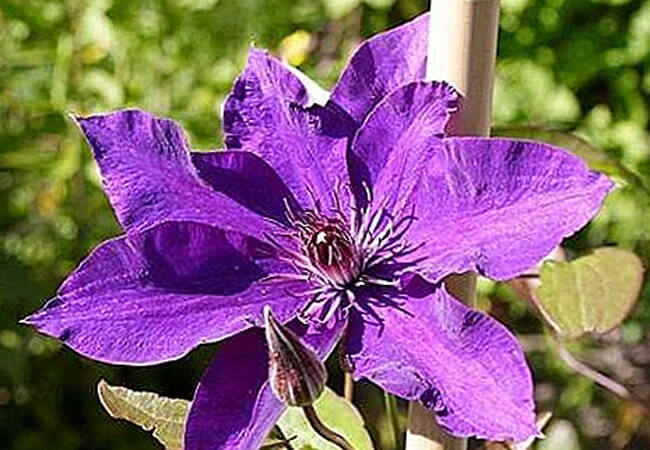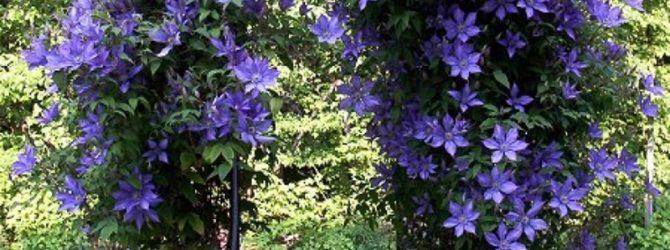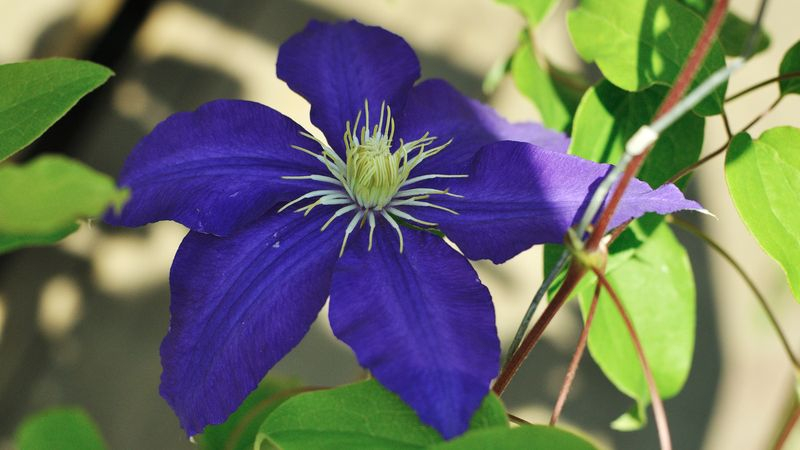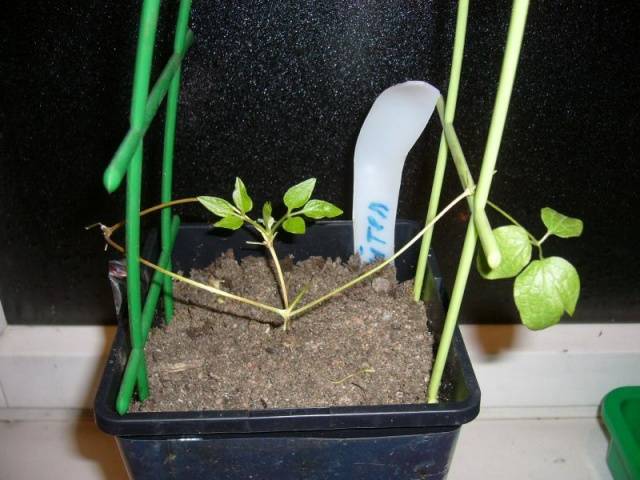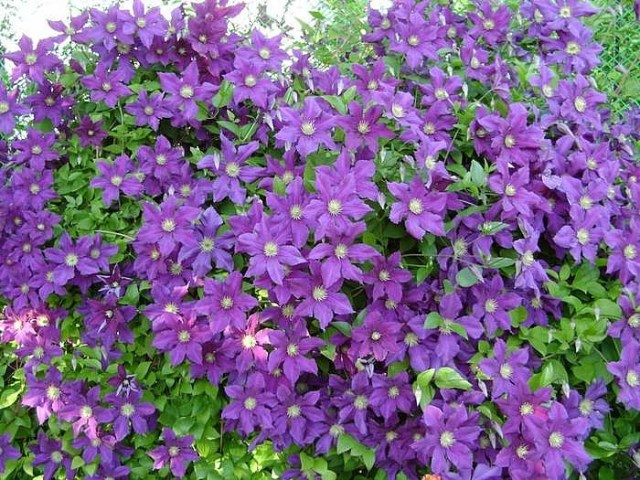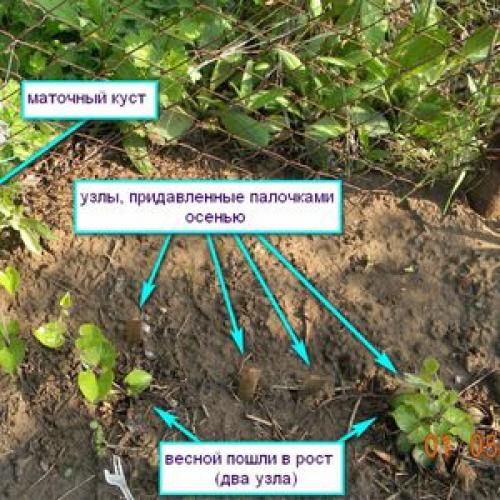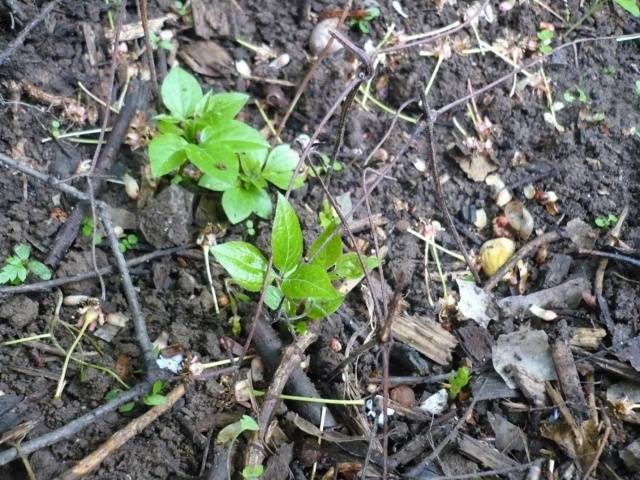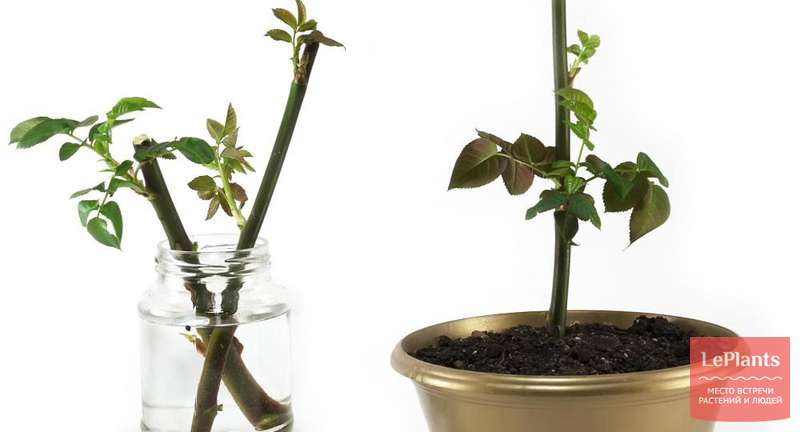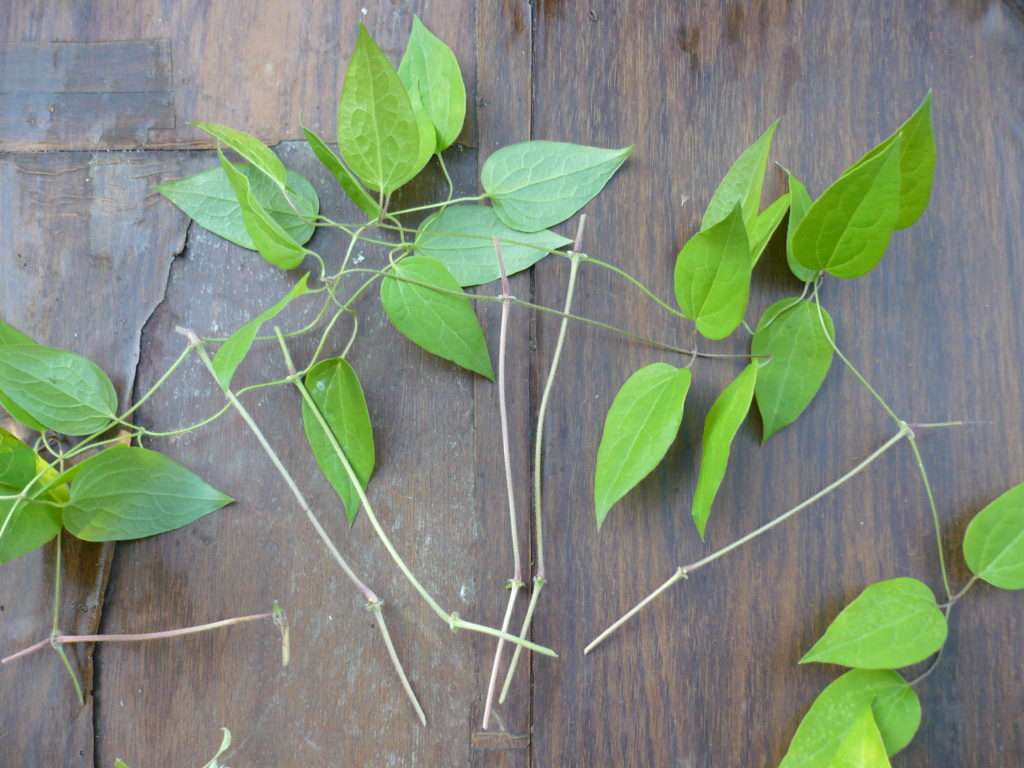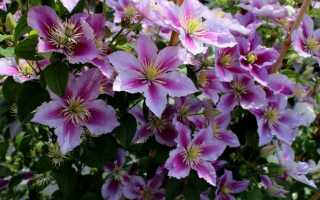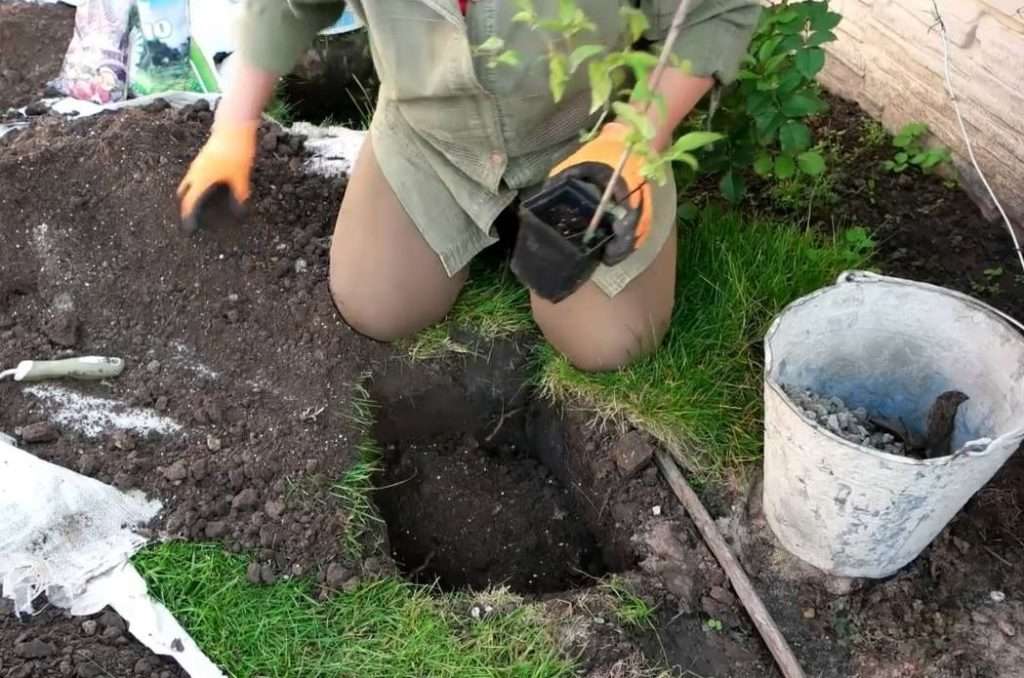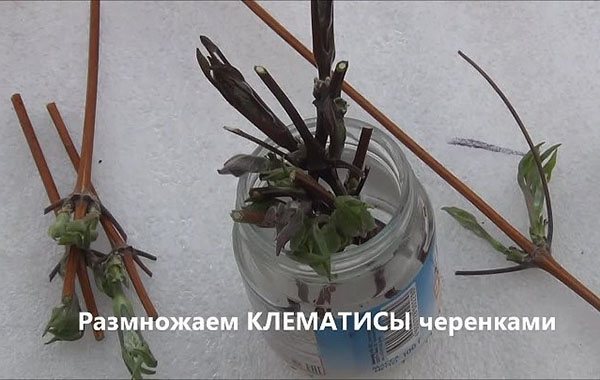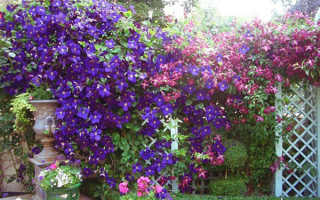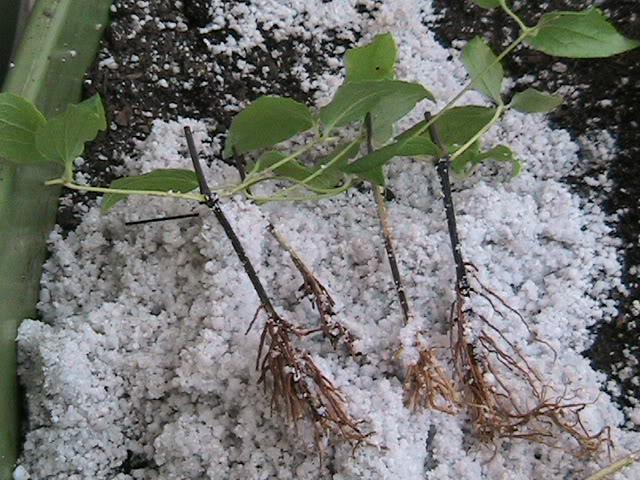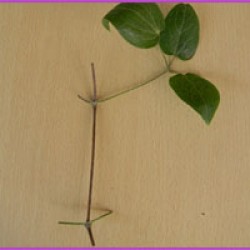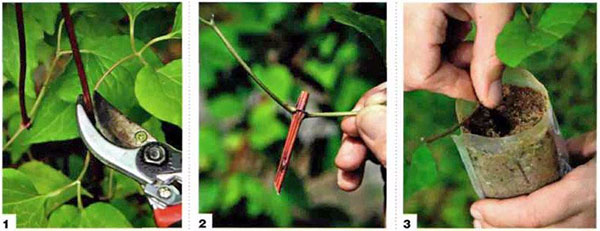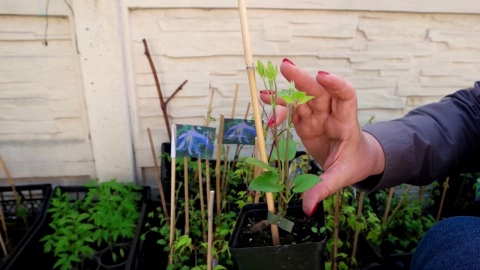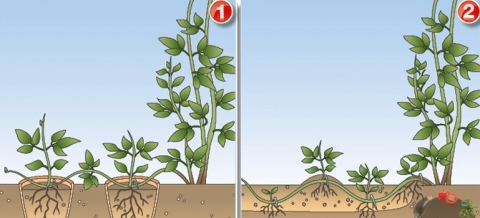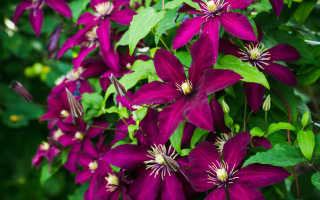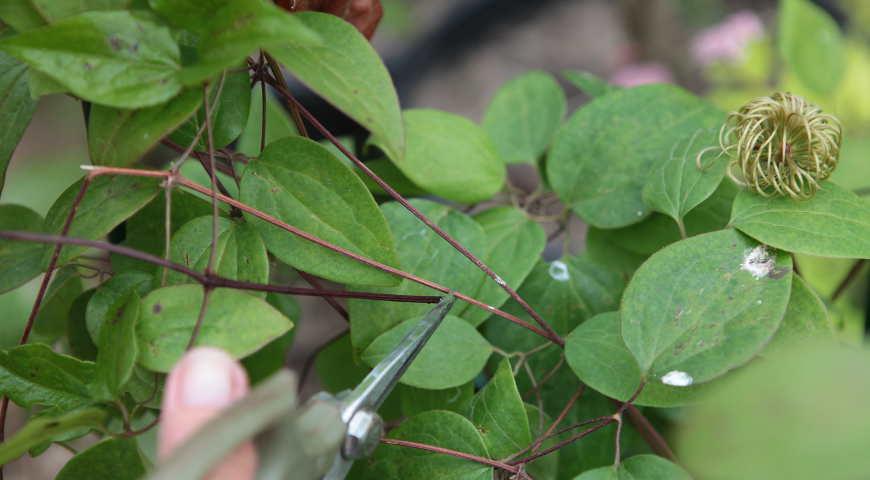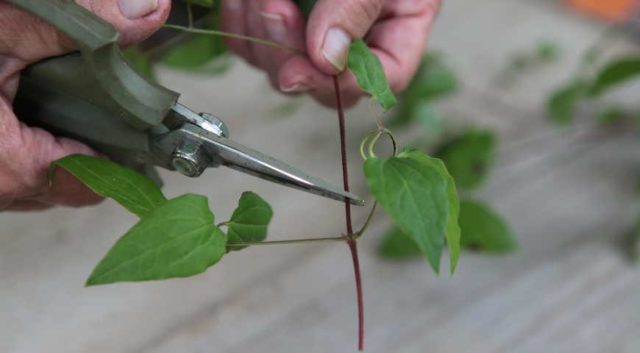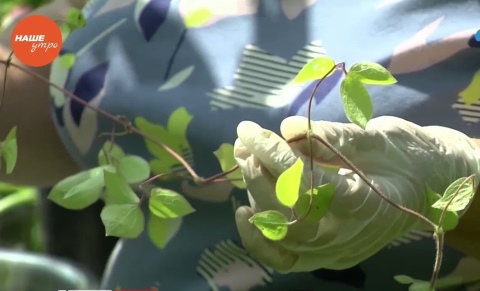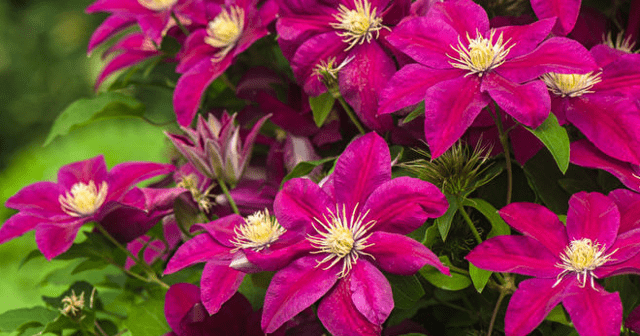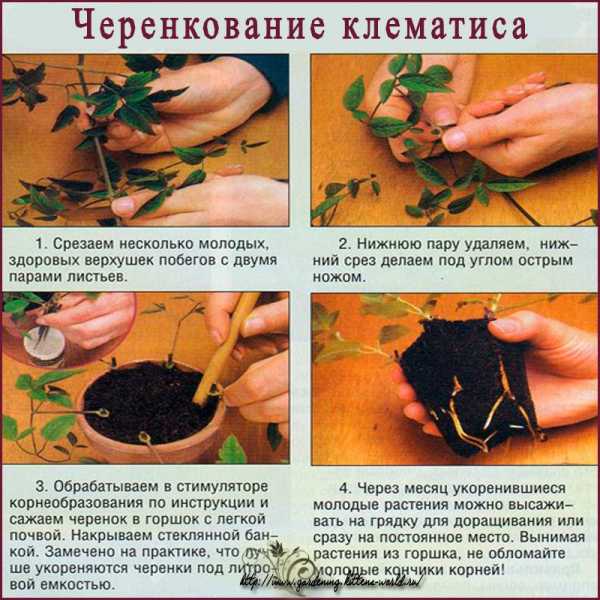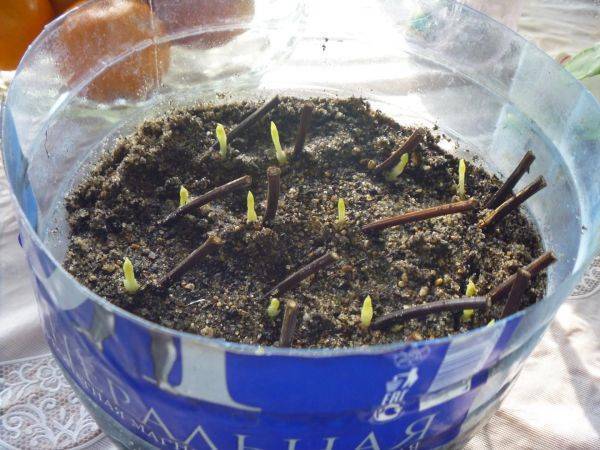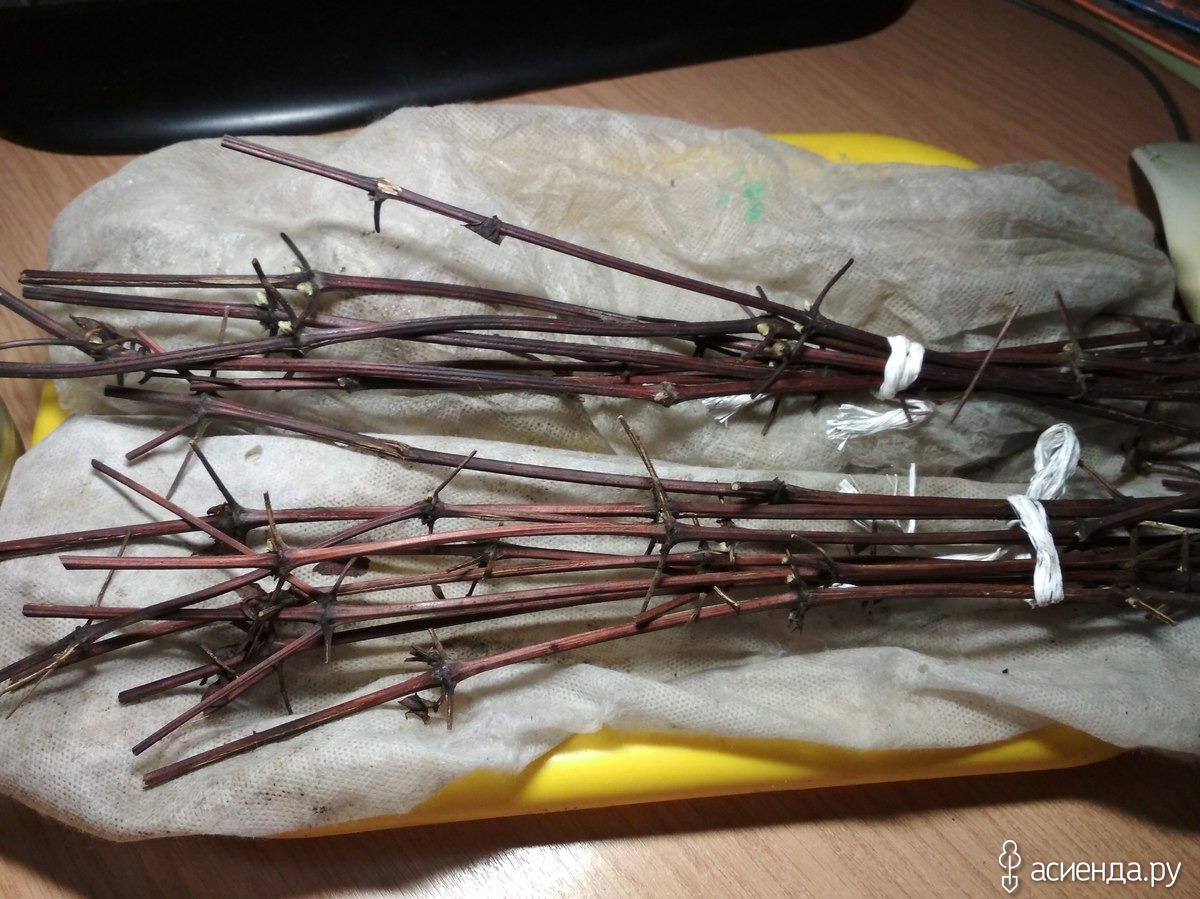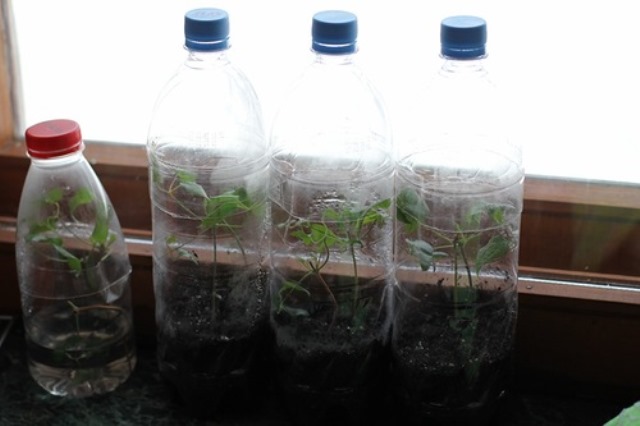When and how to cut clematis
The best time for clematis cuttings is the beginning of flowering. At this time, the percentage of rooting reaches 60 - 90%, depending on the variety. At a later time, the rooting rate decreases.
A week before harvesting the cuttings, it is good to do foliar feeding of the uterine bush with microelements, this also increases the percentage of rooting. Cuttings should be taken from a young 3-4 year old healthy bush, from the middle part of the shoot, stepping back 25-30 cm from the base of the bush.

Each stalk should have one node with two living buds in the leaf axils. The length of the stem is 4-5 cm under the knot and about 1 cm above the knot. The "stump" above the node reduces the likelihood of bud rot during rooting.

Remove one leaf completely, leaving a small piece of the petiole, being careful not to damage the bud, or shorten both leaf blades in half so that the cuttings evaporate less moisture.

Place the cuttings in a stimulant solution (1-2 drops of Epin per 100 ml of water) for 10-12 hours. Some clematis varieties root well without the use of a stimulant.

Prepare the soil in the cuttings. Mix equal amounts of peat and sand.

Sprinkle sand on top with a layer of 5 cm. Smooth. Seal the surface with a plank.

Be sure to disinfect the soil. Spill it well with a fungicide solution ("Fundazol", "Vitaros", "Maxim") prepared according to the instructions.

Use a peg or a small scoop to make a hole 5 cm deep. Dip the end of the cutting into Kornevin and place the cutting at a slight slope into the hole so that the buds barely touch the soil surface. Tighten it around the stem.

Arrange the cuttings so that the leaves do not touch each other.

Spray with a spray bottle. You can add the Epin solution to the water, which remains after soaking the cuttings.

Cover the cuticle with matte wrap to avoid direct sunlight. You can cover with two layers of plastic wrap, placing a layer of gauze between them. The most suitable temperature for root formation is + 18 ... + 22 ° C. Before the roots appear, cuttings require high humidity, so they must be sprayed 2-3 times a day with warm water and ventilated.

In a month, when the first roots appear, increase the airing time, gradually accustom the cuttings to fresh air. In 2-3 weeks after the appearance of the first roots, the buds awaken and young shoots grow. At this time, the roots become sufficiently developed in order to plant clematis cuttings for growing.

Splitting the clematis bush
Clematis older than 5-6 years, if they have formed a large number of shoots, can be divided into several parts. This is a fairly simple method that allows you to quickly achieve active growth and not wait several years before reaching maximum decorative effect (plants will bloom already in the year of separation). But it should be remembered that clematis - a steeplejack is not so simple. The plant is afraid of root injuries, transplants are hard to bear, and even separation is even more so. It is better to resort to division when the plant itself needs it, only in two cases:
- if necessary, move the vine to a new place or need for a transplant due to other objective factors;
- with a strong growth of clematis with a visible need for rejuvenation and a loss of decorativeness (usually typical for varieties with dense tillering).
The planting site must be prepared in advance by improving the soil and preparing the planting pits.
The separation procedure is carried out even in the middle lane either in autumn or early spring.The latter option, although less dangerous in terms of preparing for winter, is fraught with great difficulties. The thing is that the separation must be carried out as soon as the weather permits, the snow melts and the soil thaws, but the shoots should not start growing before the separation, the buds can only be slightly swollen. The timing of a possible separation in this case is very limited, clematis lags behind in development, so the autumn separation is considered simpler and less risky.
The procedure for dividing clematis is quite complicated:
Prepared planting holes are watered abundantly, saturating the soil with moisture. If possible, it is better to add a growth stimulant to the water for irrigation.
If the plant is divided in the fall, the aerial part is cut off, leaving 2-3 pairs of buds
Clematis bushes are very carefully dug out, keeping a large supply of soil around the roots and trying not to harm the long "laces". The earth is gently shaken off and washed so that the structure of the plant can be seen.
After inspection, the bush is divided in any convenient way into large divisions containing a large bunch of roots, at least 2 - 3 shoots with visible lower buds of renewal
If you have experience in dividing clematis, you can also separate one shoot at a time, but the larger the cut, the better. The best option is not to divide even highly overgrown clematis into more than 2-3 parts.
The roots are examined, shortened, damaged and dry parts are removed. Delenki are soaked in a solution of fungicide or potassium permanganate.
Clematis are carefully planted in a new place, observing the general planting rules, be sure to deepen the root collar by 10 cm.
There is also an alternative way to divide clematis - without digging. The bushes are dug on one side, creating a trench or hole up to 70 cm deep, trying not to damage the roots and moving in a circle. From the excavated side, the base of the bush is carefully exposed manually and the shoots with roots are cut off with a sharp pruner or knife, the rest of the bush is added back and watered. Separated parts are handled in the same way as ordinary divisions.
Watering after planting is not carried out: the supply of water poured into the planting hole is quite enough for an adapting plant. The first watering is carried out only a week after planting the divisions. Growth stimulants can also be added to the water for irrigation.
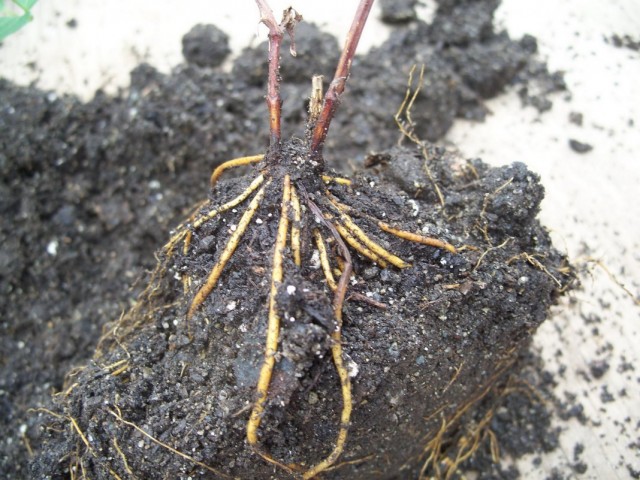 Reproduction of clematis by dividing the bush. hummingbirdfarm
Reproduction of clematis by dividing the bush. hummingbirdfarm
When is the best time to propagate a plant?
The nuances of breeding creepers include the exact date of planting in open ground. Experienced gardeners have identified 2 suitable time periods:
- In the spring.
- In the autumn.
Both options require compliance with the accompanying conditions, a combination of air temperature and soil moisture
In the spring, it is important to transfer the seedling before the heat has set in, and in the fall, before the cold has begun. Both methods are equivalent, subject to simple planting rules, they give the expected result - a healthy, flowering plant
Gardeners practice soaking the seedling before planting - for an hour, in water, with the addition of potassium permanganate ("potassium permanganate"). A temporary "residence" of clematis is acceptable in any suitable place in the garden or plot.
Reproduction is carried out in spring or autumn, to choose from. But the autumn is considered more preferable by connoisseurs. Breeding of clematis is applied using seeds, cuttings, cuttings or by dividing a bush. The first method is more often used for plants with small inflorescences; for the rest, cuttings, division and layering are used.
In the spring
For the landing procedure to be successful, you first need to dig a hole of sufficient depth. At the bottom, a drainage layer must be created (at least 15 centimeters). A brick break or large rubble will do. The mixture itself for a clematis seedling is prepared in several ways. For example, they mix fertile soil with rotted manure, wood ash, sand. Superphosphate is added to the soil as a fertilizer. Everything is thoroughly mixed, poured into the pit.
In autumn
Experienced “clematists” call September as a temporary period for autumn planting, and not October, as is customary for some other plants. If the required deadline is missed, it doesn't matter. The seedling will overwinter in the back room, cellar or basement, and in the spring it will go to the ground.
A plant is able to develop steadily in one place for 3 decades, if the planting point is correctly (and immediately) determined. A seedling, and an adult clematis, is contraindicated in sunbathing in an open space. You should also not plant close to the walls of buildings (fences or fences). Liana is not durable - strong gusts of wind can easily break off flowers or break the stem.
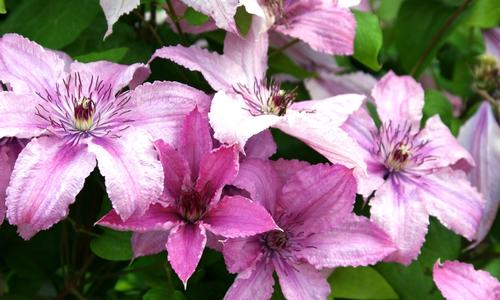
A plant planted correctly and on time will get stronger over the winter, gain strength, and with the arrival of heat, it will begin to delight with large and frequent inflorescences. In the fall, a transplant or reproduction of clematis is carried out. To do this, use the division of bushes or the method of layering.
The summer period is used for propagation of clematis. It's better than buying a "pig in a poke" - cuttings from private owners or garden partnerships with an unknown future. And cheaper, besides. To do this, choose the period from May to July (the exact date depends on the climatic zone).
Reproduction of clematis by seeds
Only wild-growing or species clematis can be obtained from seeds, since the varieties obtained by breeding almost do not retain their fruiting abilities. Clematis are divided into three groups based on seed size. Species with small seeds are characterized by fast germination - from 15 days to 3 months. With medium (in size) seeds, the emergence of clematis shoots takes from 1.5 months to six months, with large seeds - from 2 to 8 months. The sowing lines also directly depend on the size of the seeds. Small seeds of clematis are always sown in spring, in March-April, and medium and large ones - after collection or before winter, or with stratification.
Sowing seeds of clematis is carried out immediately into the soil, on seedling beds. If desired, they can be sown in boxes or containers, followed by diving into the ridges (but the plants develop worse and slower compared to those grown in open soil).
There are two strategies for sowing clematis seeds:
- Autumn (sub-winter) sowing - is used only for large and medium-sized clematis seeds. The sowing site is prepared, if necessary, improving and loosening the soil. Seeds are rarely sown, in small holes or grooves, burying 4-5 cm into the soil.
- Spring sowing. This option for medium and large clematis seeds requires preliminary stratification: they are kept in cool temperatures (not lower than 0 and not higher than 5 degrees Celsius) for 12-14 weeks. Most often, seeds are stored in the refrigerator for up to 3 months, after mixing them with wet sand. Small seeds do not need processing. The seeding technique is the same.
Diving is carried out at the stage of the first or second pair of leaves, mulching the aisles to protect young plants from overheating. It is advisable to shade the seedlings until the third pair of leaves appears. Young clematis are provided with regular watering, loosening and weeding.
Planting clematis obtained from seeds to a permanent place is always carried out after a year, in autumn or spring. For the winter, the plants are preserved by hilling, after cutting off the shoots. Young plants are planted so that the root collar is recessed by 3-4 cm. In plants, the shoots are regularly pinched over the second pair of leaves to thicken.
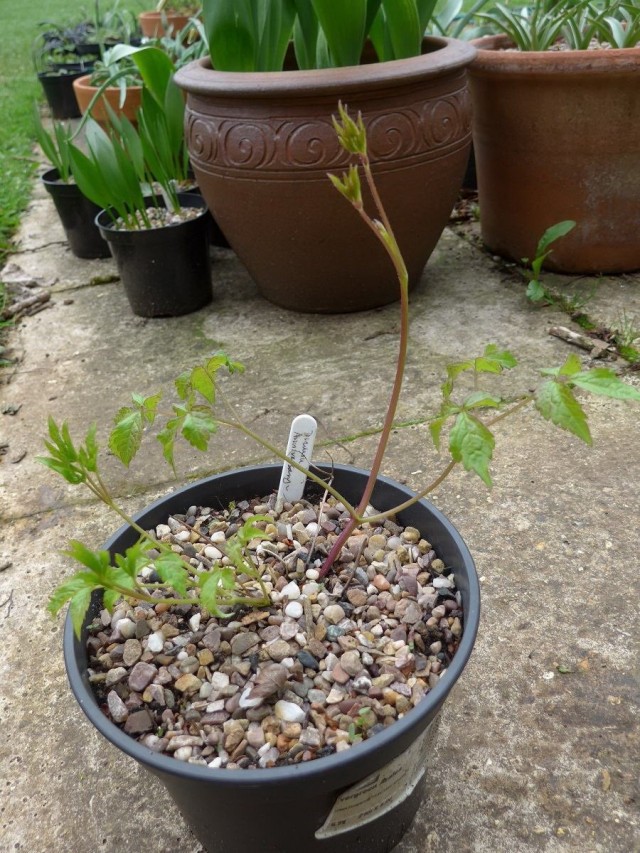 A clematis sapling grown from seeds. nutcutlet
A clematis sapling grown from seeds. nutcutlet
Basic breeding rules
Reproduction of these flowering vines is carried out in several ways, using:
- seeds;
- cuttings;
- layering;
- parts of the mother bush (delenki).
Another popular method is plant propagation by grafting. It is often used by breeders when breeding rare varietal lianas.
The seed propagation method of clematis is the least popular among florists. This is due to the fact that varietal plants do not transmit their qualities to the offspring through seeds, due to which the results of the work carried out by the florist may not at all meet expectations.
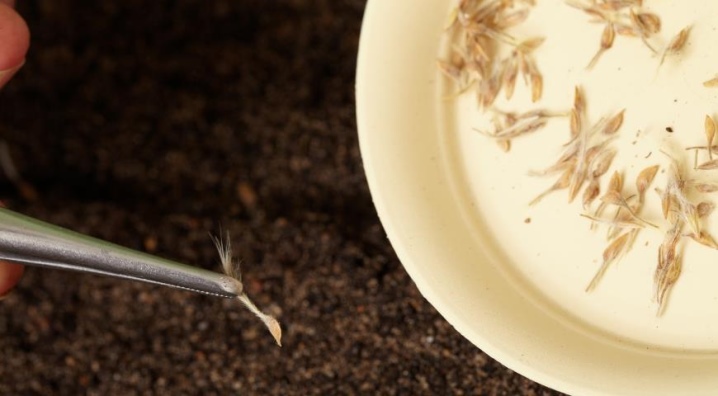
The simplest and most effective are vegetative breeding methods for clematis, in particular cuttings and rooting of cuttings. These methods have the highest efficiency and make it possible to obtain young healthy plants with all the varietal characteristics of the parent bush.
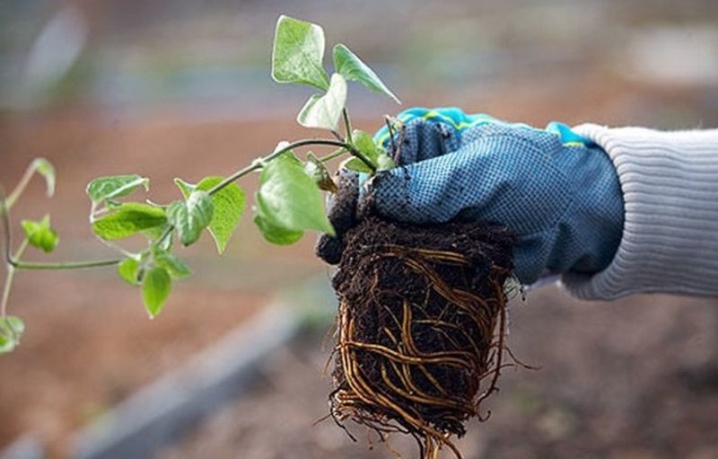
Reproduction of clematis by dividing the mother bush is a method used only by experienced growers. An incorrectly performed procedure not only seriously injures the plant, but also often leads to its death.
When breeding clematis in one way or another, you should take into account the current season and the recommended timing of the procedure. So, the sowing of the seeds of these flowering plants is carried out in spring and autumn, the layers begin to take root in the summer, and they begin to divide the bushes either in the fall or in early spring (in the middle lane). Clematis cuttings are usually harvested in late spring or early summer (the best time is late May or early June).
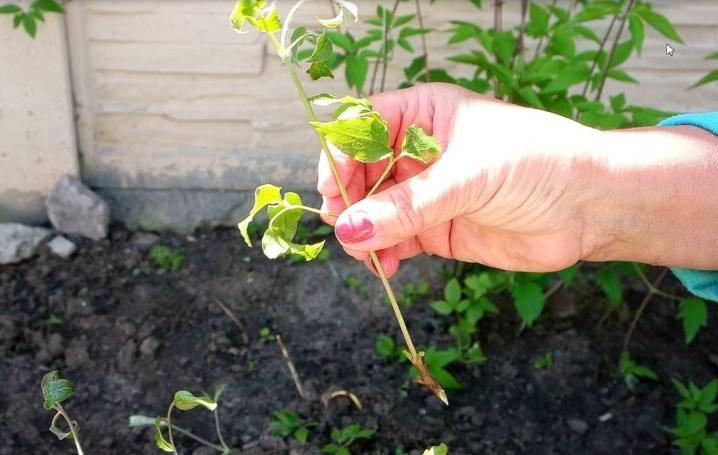
Another condition that must be taken into account when starting to breed clematis is the climatic features of your region. The timing of the planned procedures depends on this factor, as well as the choice of the most suitable varieties.
So, thermophilic and whimsical varieties of clematis are best not planted or bred in regions with a harsh climate, for example, in the Urals or Siberia. For these regions, frost-resistant zoned varieties are recommended that are able to take root and bloom in unfavorable conditions ("Gypsy Queen", "Bella"). Planting and reproduction of clematis in regions with a harsh climate begins at the time recommended for a particular variety.
To obtain vegetative planting material (cuttings, cuttings), strong, well-developed, sufficiently mature and healthy bushes should be used. Clematis that are too young (less than 3 years old), weakened, flowering, diseased or damaged clematis cannot be used as mother plants. Damage arising during the harvesting of planting material can dramatically worsen the health of these flowering vines and even cause their death.
